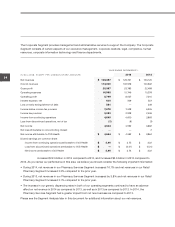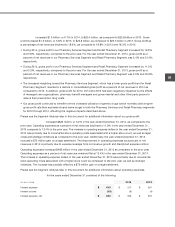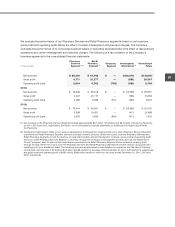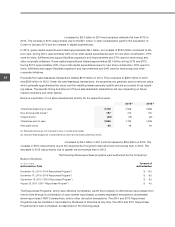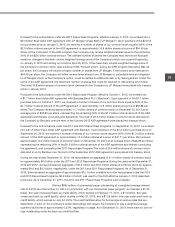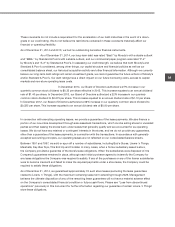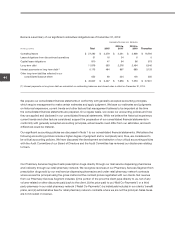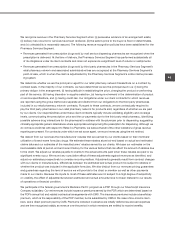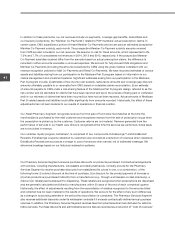CVS 2014 Annual Report Download - page 35
Download and view the complete annual report
Please find page 35 of the 2014 CVS annual report below. You can navigate through the pages in the report by either clicking on the pages listed below, or by using the keyword search tool below to find specific information within the annual report.
33
2014 Annual Report
store sales would have been approximately 350 basis points higher for the year ended December 31, 2014 if
tobacco and the estimated associated basket sales were excluded from both the years ended December 31, 2014
and 2013.
• Pharmacy same store sales rose 4.8% in the year ended December 31, 2014, as compared to the prior year.
Pharmacy same store sales were positively impacted by same store script growth of 4.1%, partially offset by
the impact of the increase in generic dispensing and reimbursement pressure. Pharmacy same store sales for the
year ended December 31, 2014 were negatively impacted by approximately 140 basis points from the implemen-
tation of Specialty Connect. Specialty Connect transitioned all specialty prescriptions to the Pharmacy Services
Segment, as they are being processed through the Company’s specialty mail order pharmacies. The implementa-
tion of Specialty Connect had a greater effect on revenues than on prescription volumes due to the higher dollar
value of specialty products. Pharmacy same store sales were also negatively impacted by a lower incidence of flu
compared to last year’s strong flu season and extreme weather conditions across much of the United States in the
first quarter of 2014, which led to fewer physician visits and prescriptions written.
• Pharmacy revenues continue to be negatively impacted by the conversion of brand name drugs to equivalent
generic drugs, which typically have a lower selling price. Pharmacy same store sales were negatively impacted
by approximately 160 and 540 basis points for the years ended December 31, 2014 and 2013, respectively, due
to recent generic introductions. The decrease in the impact from 2013 to 2014 was primarily due to a smaller
impact from new generic drug introductions. In addition, our pharmacy revenue growth has also been affected
by continued reimbursement pressure, the lack of significant new brand name drug introductions, as well as an
increase in the number of over-the-counter remedies that were historically only available by prescription.
• As of December 31, 2014, we operated 7,822 retail stores compared to 7,660 retail stores as of December 31,
2013 and 7,458 retail stores as of December 31, 2012. Total net revenues from new stores contributed approxi-
mately 1.1%, 1.0% and 1.1% to our total net revenue percentage increase in 2014, 2013, and 2012, respectively.
• Pharmacy revenue growth continued to benefit from increased utilization by Medicare Part D beneficiaries, our
ability to attract and retain managed care customers and favorable industry trends. These trends include an
aging American population; many “baby boomers” are now in their fifties and sixties and are consuming a greater
number of prescription drugs, as well as expanded coverage from the Patient Protection and Affordable Care
Act and the Health Care and Education Reconciliation Act (collectively, “ACA”). In addition, the increased use of
pharmaceuticals as the first line of defense for individual health care also contributed to the growing demand for
pharmacy services. We believe these favorable industry trends will continue.
Gross profit
in our Retail Pharmacy Segment includes net revenues less the cost of merchandise sold during the
reporting period and the related purchasing costs, warehousing costs, delivery costs and actual and estimated
inventory losses.
Gross profit increased $1.2 billion, or 5.8%, to $21.3 billion in the year ended December 31, 2014, as compared to
the prior year. Gross profit as a percentage of net revenues increased to 31.4% in year ended December 31, 2014,
from 30.6% in 2013. Gross profit increased $1.0 billion, or 5.3%, to $20.1 billion for the year ended December 31,
2013, as compared to the prior year. Gross profit as a percentage of net revenues increased to 30.6% for the year
ended December 31, 2013, compared to 30.0% for the prior year.
The increase in gross profit dollars in the year ended December 31, 2014, was primarily driven by increases in the
generic dispensing rate, same store sales and new store sales, as well as favorable purchasing economics. The
increase in gross profit dollars for the year ended December 31, 2013, was primarily driven by increases in the
generic dispensing rate, same store sales and new store sales. The increase in gross profit as a percentage of net



